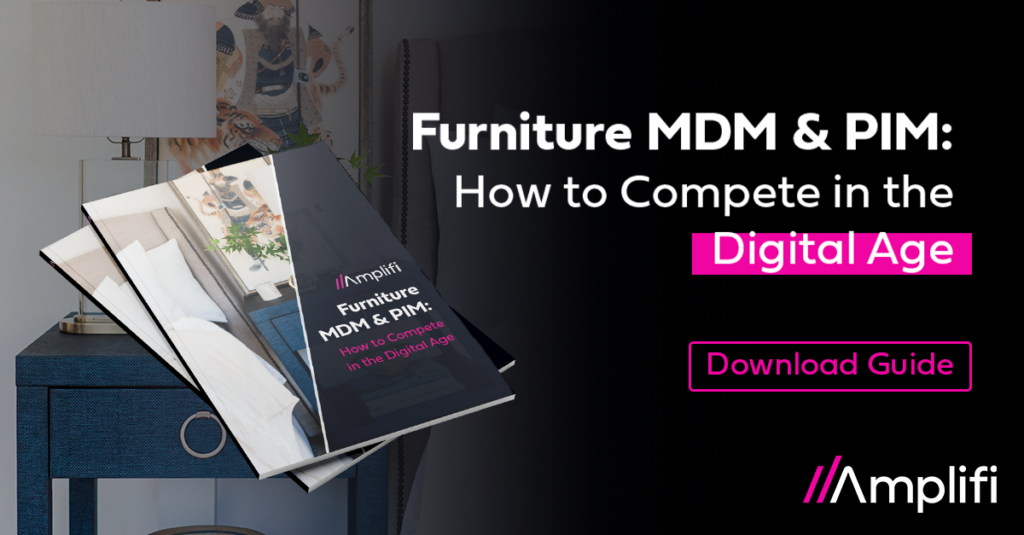Furniture manufacturers are in a unique position. Experts predict the furniture market will grow to $720 billion by 2028. However, it’s also highly fragmented with competitors.
To cement your status as a market leader, you need a solid data foundation. But meeting that goal is more challenging than a quick technology fix.
In this article, we’ll discuss effective data management, why it matters for furniture brands and manufacturers, and the steps required to get ahead.
How important is data management for furniture manufacturers?
Most brands and manufacturers recognize the importance of good data and over 50% use some type of data management platform. Yet Gartner found that many of these businesses believe poor quality data is responsible for up to $15 million in losses per year.
Where’s the disconnect? In most cases, the company needs to implement the right mix of people, processes, and technology to get the desired results.
Furniture brands targeting digital transformation often struggle to launch or scale e-commerce due to issues with organizing, enriching, or publishing their data. Other pain points include slow product launches, frustrated employees, missed revenue goals, and high costs. But these “business problems” are typically data problems in disguise.
As we shared in our last article, the volume, and variety of furniture product data is a considerable challenge. Most manufacturers deal with thousands of attributes and options related to fabrics, configurations, kits, patterns, accessories, and materials. Without a single source of truth, wrangling this data feels overwhelming.
If this sounds familiar, you’re not alone. As more furniture companies prioritize digital transformation, well-managed data will become a clear competitive advantage.
Recommended: Bassett Furniture scales its showroom experience from web to store with PIM
How does data management help you differentiate?
Furniture enterprises with solid data management can respond quickly to market disruption and trends — like the fast rise of e-commerce, ESG/sustainability requirements, and a challenging supply chain. From product discovery and customization to ordering, delivering, and returns — data management supports a seamless customer experience across channels.
Internally, processes run smoothly to support an efficient product lifecycle. With data out of silos, teams can collaborate freely — focusing on high-value work instead of tracking down data or manual tasks.
Crucially, the business gains reliable data for decision-making. Insights around inventory, pricing, suppliers, sales, compliance, and manufacturing practices help you optimize product offerings, increase revenue, and reduce costs.
The sum of these parts is a connected furniture ecosystem. One that empowers you to deliver competitive products faster — with an experience that feels intuitive and easy for your customers.
Recommended: The Future of Furniture Data infographic
What’s the ideal way to kickstart your data management?
As furniture companies search for ways to support growth, master data management (MDM) and product information management (PIM) rise to the top as effective, secure, and scalable solutions.
A core benefit of MDM and PIM is gaining a single source of data truth — with accurate and consistent data underpinning all your initiatives.
But before you get there, you need the right data strategy. This is a crucial step to starting your MDM journey or re-aligning what’s already in place.
Your strategy will help guide solution design and implementation decisions. For example, many furniture companies want to manage complex data relationships in order to streamline configurable products. In those cases, options-based SKU management rises to the top of the wish list. Other organizations may have an e-commerce launch date looming and prefer to focus on product content enrichment and syndication.
To help formulate your data strategy, you’ll want to consider questions like:
- What are my business objectives now and for the future?
- What type of data domains are most important to my business?
- What process inefficiencies or roadblocks cause the most pain for my organization?
- Do I need a data software tool, and if so, what type would work best for my business?
- Do I have internal support? Or do I need help building a business case for stakeholders?
- Are there readiness gaps and areas to address regarding my team, processes, or data maturity?
To develop the right strategy, it helps to work with a partner that understands the nuances of your industry and can help uncover and align your data and business objectives.
Also, remember that you can tackle specific issues or opportunities one at a time. Taking a phased implementation approach helps minimize risks and deliver fast results, making it an effective strategy for your immediate needs and long-term objectives.
Recommended Resource: NFM overcomes legacy systems with Data Services and PIM
What other data management steps should you consider?
In addition to nailing down your data strategy, there are other vital elements to ensure you make the most out of your MDM or PIM program.
The foundation of a solid data management program lies in a purpose-built solution design. This may require customizing your data model, integrating seamlessly with other systems, ensuring smooth data syndication, automating workflows, and implementing intelligent business rules that align with your objectives.
Moving your data from existing systems to a new platform is a critical step. Handling this process with care is essential to maintain data accuracy and completeness. By ensuring a meticulous—yet strategic—transfer, you can minimize the risk of data loss and ensure that your new system of record starts on the right track.
Build Trust with Data Governance
Data governance is a critical component of any effective data management program. It involves ensuring data quality, protecting data security, and complying with industry regulations. By maintaining accurate and reliable data, safeguarding sensitive information, and adhering to data governance best practices, furniture manufacturers can build trust with customers and partners while reducing the risk of data breaches and compliance penalties.
Change management is vital for successful user adoption and engagement. By effectively communicating the benefits of the new system, providing training and support, and addressing any concerns, you create an environment where employees embrace your data management program and use it to its full potential.
Recommended Reading: MillerKnoll targets digital commerce and product configurability with PIM
The help and expertise you need
With the right people, processes, and technology in place, you can create a data management program that drives your vision and objectives forward.
Selecting the ideal partner is another essential step. Brian Claspell, CIO of Bassett Furniture—an Amplifi client—recently noted:
“Just as important as selecting the PIM solution is selecting your integration partner. At Bassett, we looked for a data partner that was a cultural fit for us and a partner proven to deliver — and that led us to Amplifi.”
Want to learn more or share insights with your team? Download our PIM & MDM for Furniture Guide now.
Ready to take the first step? Call or email us. We’re here to help.



